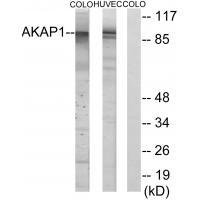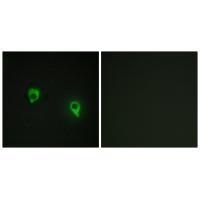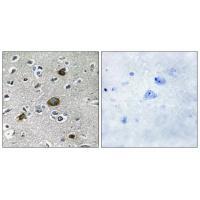


| WB | 1/500-1/3000 | Human,Mouse,Rat |
| IF | 咨询技术 | Human,Mouse,Rat |
| IHC | 1/50-1/100 | Human,Mouse,Rat |
| ICC | 1/100-1/500 | Human,Mouse,Rat |
| FCM | 咨询技术 | Human,Mouse,Rat |
| Elisa | 咨询技术 | Human,Mouse,Rat |
| Aliases | A kinase anchor protein 1; mitochondrial precursor; A-kinase anchor protein 149 kDa; AKAP 149; AKAP149 |
| Entrez GeneID | 8165; |
| WB Predicted band size | 90kDa |
| Host/Isotype | Rabbit IgG |
| Antibody Type | Primary antibody |
| Storage | Store at 4°C short term. Aliquot and store at -20°C long term. Avoid freeze/thaw cycles. |
| Species Reactivity | Human |
| Immunogen | Synthesized peptide derived from internal of human AKAP1. |
| Formulation | Purified antibody in PBS with 0.05% sodium azide. |
+ +
以下是3篇与AKAP1抗体相关的参考文献及摘要概括:
---
1. **文献名称**: *"A-kinase anchoring protein 1 (AKAP1) regulates mitochondrial protein synthesis and cristae structure through interaction with translation machinery"*
**作者**: De Rasmo D, et al.
**摘要**: 本研究利用AKAP1特异性抗体,通过免疫共沉淀和免疫荧光技术,揭示了AKAP1通过锚定线粒体mRNA翻译相关蛋白调控线粒体嵴结构和氧化磷酸化功能的机制。
---
2. **文献名称**: *"AKAP1 promotes tumorigenesis and chemoresistance in breast cancer via suppression of mitochondrial apoptosis"*
**作者**: Wang Y, et al.
**摘要**: 该研究使用AKAP1抗体进行免疫组织化学和Western blot分析,发现AKAP1在乳腺癌组织中高表达,并通过抑制线粒体途径的细胞凋亡促进肿瘤生长及化疗耐药性。
---
3. **文献名称**: *"AKAP1 deficiency exacerbates neuronal death in Parkinson's disease models via impaired PKA-mediated mitophagy"*
**作者**: Chen X, et al.
**摘要**: 通过AKAP1抗体标记,研究者发现AKAP1敲除导致帕金森病模型中神经元线粒体自噬(mitophagy)功能受损,加剧多巴胺能神经元死亡,提示AKAP1在神经退行性疾病中的保护作用。
---
如需具体文献来源或补充信息,可进一步提供PMID或DOI。
AKAP1 (A-kinase anchoring protein 1) is a scaffold protein belonging to the AKAP family, which spatially organizes signaling molecules, particularly protein kinase A (PKA), by tethering them to specific subcellular compartments. Primarily localized to mitochondria and the endoplasmic reticulum, AKAP1 plays a critical role in mitochondrial dynamics, apoptosis, and metabolic regulation by coordinating PKA-mediated phosphorylation events. It is also implicated in cellular responses to oxidative stress and hypoxia. The AKAP1 antibody is a key tool for studying these processes, enabling the detection and visualization of AKAP1 expression, localization, and interactions in various experimental models.
AKAP1 antibodies are widely used in techniques like Western blotting, immunofluorescence, and immunoprecipitation. They help identify AKAP1 isoforms (e.g., ~100 kDa full-length protein) or post-translationally modified forms (e.g., phosphorylated variants). Specificity is validated through knockout (KO) controls or siRNA knockdown. Research applications span mitochondrial biology, metabolic disorders, neurodegenerative diseases, and cancer, where AKAP1 dysregulation has been linked to altered energy metabolism or cell survival. These antibodies also aid in exploring AKAP1’s role in compartmentalized cAMP/PKA signaling, providing insights into tissue-specific regulatory mechanisms. Commercial AKAP1 antibodies are typically raised against conserved epitopes across human, mouse, and rat homologs, ensuring broad experimental utility.
×